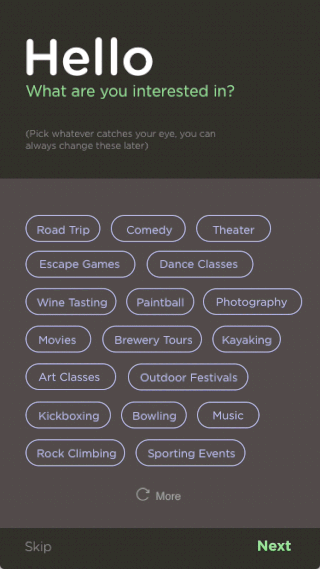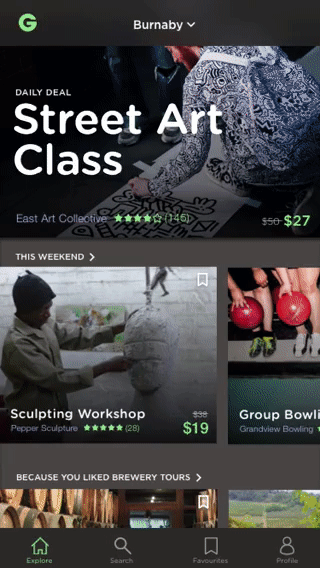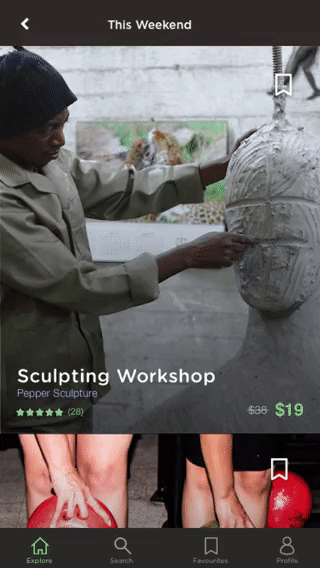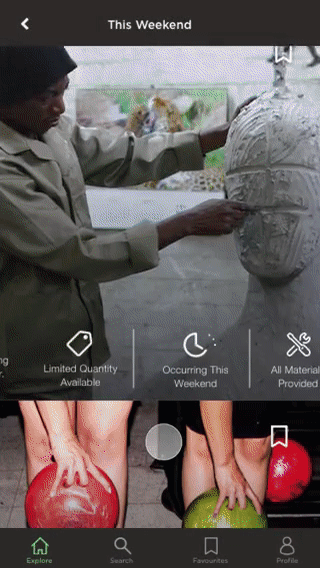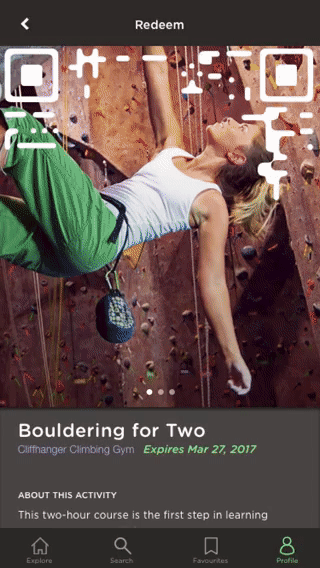
Groupon
Groupon is an American global e-commerce marketplace connecting subscribers with coupons for goods, services and activities. After going public, Groupon expanded too much, too fast, and lost the focus of their brand. Re-positioning their platform to sustain local relationships can help Groupon stand out in the market and secure long term stability.
This case study was created as part of a graduation project course over the span of two weeks. As a part of the three person team I was responsible for interface, interaction and experience design.
Problem
In 2010 Groupon received a 6 billion dollar offer from Google, instead deciding to go public in 2011 with an IPO value of 750 million. Their stock value has been decreasing steadily since.
Groupon's original value proposition was to not sell overstock goods, however after going public Groupon shifted from offering daily deals to featuring coupons on everything from personalized mugs to all-inclusive vacations. An overload of choices was thrown at the user, with little opportunity for customers to personalize their experience. Their merchant partners also suffered, with Groupon attracting a customer base of extreme couponers, unlikely to increase customer retention for the merchants.
Approach
Groupon has lost value for both their customers and merchants. We looked at the pain points for the current user, along with looking at opportunities to build trust and sustain local relationships. The design decisions are accompanied by prototypes, which illustrate how our design was informed by each point along the journey.
1. Onboarding: Quick Personalization
There is currently a lack of personalization in Groupon’s platform, where the user is unable to customize their experience. Although user's are able to set preferences, the system does not take those preferences into account in content surfaced to the user. Onboarding the user, asking them for allows us to learn their preferences and get them started with personalized content.
2. Explore: Personalized Feed
The explore page surfaces content personalized to the user's preferences. The organization of content took inspiration from the way Netflix organizes content, through specific “channels” that relate to your browsing habits. The user influences channels and content that appears, based on their onboarding along with interactions with bookmarked deals.
3. Explore: Preview + Favourites
Details about deals are currently buried in the fine print or deeper within the system. This often causes the user to be frustrated and misinformed, which leads to them arriving at the merchant with limited information. We have surfaced this content for the user, where they are able to see details of the Groupon while browsing through events. Bringing the fine print to the surface aids in building trust with the user.
4. Consider: Highlight Merchant + Simplify Fine Print
The current platform is too focused on the deal itself, with little done to highlight the merchant. We gave the merchant’s info more hierarchical prominence. We took inspiration from redesigns of complex information, such as medical prescription instructions. By organizing the fine print by categories to make them more visually digestible, we reduced potential purchasing friction when trying to redeem the deal.
5. Redeem: Goodbye Paper
Paper coupons are easily forgotten or lost, and created challenges on the merchant’s side of registering used Groupons. By limiting the Groupons to exist only within the mobile platform, users can quickly present their specific code to be scanned, making the redeeming process reliable and seamless.
6. Reflect: Give Feedback
Currently Groupon’s reviews are sparse and do not convey authenticity. Often, businesses listed on Groupon don’t have reviews or have a skewed rating as you are only able to see the top 3 comments. After redeeming their Groupon, the customer is able to view and add their photos from the event or experience.
This helps you share and remember past events, and also can be used by future customers in the consideration stage. If you didn't have a good experience, you can give Groupon and the merchant feedback as to why. This information could help Groupon with quality control, limiting the number of merchants and reducing in-app competition. Groupon would incentivize leaving feedback by giving out Groupon points. This would also help with customer retention.
Conclusion
Groupon has a need to regain trust, both with their customers and their merchants. They got off their project road when they stopped focusing on quality recommendations, causing them to lose the attention of their original local target market. In creating a mobile experience that allows for personalization and puts the discovery of interesting activities at the forefront, they have an opportunity to rebuild their relationships with local customers, and subsequently with their local business partners.
“To connect local commerce, increasing consumer buying power while driving more business to local merchants through price and discovery.” - Groupon’s mission statement
